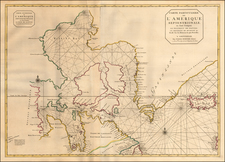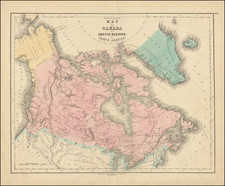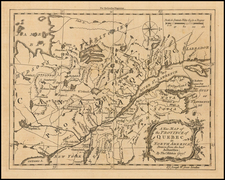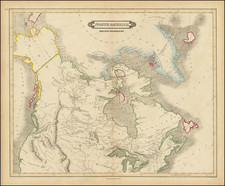Fine example of John Arrowsmith's rare map of the Fraser River Gold regions, published in London in 1858.
The map covers the areas from Fort Kamloops to Fort Okanagan and from Howe Sound to Fort Colvile. Includes Mackay's and Indian trails, routes, forts, gold fields, rivers, lakes, mountains, range dividing Columbia and Fraser Rivers. It depicts the routes to the gold diggings via Whatcom in Bellingham Bay and via Fort Langley on the Fraser River. It also shows MacKay's Route to the north, locating an area west of the Harrison River identified as "Much Gold Bearing Quartz Rock." To the southwest, the routes from Grand Coulle and the Columbia River via Fort Okangan and the Okanagan River are shown, along wit hthe route from Fort Colville and Walla Walla, showing the gold region on the Dease (Kettle) River and upper Columbia River.
Arrowsmith draws this finely executed map from Alexander C. Anderson's "Map showing the different Routes of Communication with the Gold Region on Fraser River, Compiled from Original Notes . . . ," published by J.J. LeCount in San Francisco in 1858 on a scale of 18 miles = 1 inch, the first separately issued map to focus on the region following the discovery of gold in 1858, which accompanied his Hand-Book and Map To the Gold Region of Frazer's and Thompson's Rivers . . .
The map accompanied the Papers Relative to the Affairs of British Columbia . . . presented to both Houses of Parliament by Command of her Majesty, 18 February 1859, the first report to British Parliament on the newly formed Crown Colony of British Columbia, established in August 1858.
Alexander Caulfield Anderson was a mapmaker of great importance in the region. First employed b ythe Hudson's Bay Company in 1831, he spent over 50 years in western Canada as an explorer, fur trader, trailblazer, cartographer, customs agent, businessman, farmer, amateur historian, Indian Reserve Commissioner, and fisheries inspector. He remained with the HBC from 1832 to 1854, where he worked for Peter Skene Ogden, was appointed to numerous forts in New Caledonia and what is now Washington State. He was based at Fort Alexandria on the Fraser River from 1841-1848 and from there led three expeditions to explore trade routes from Kamloops to Fort Langley. These expeditions, with the assistance of a Native guide "Blackeye", resulted in the path via the Coquihalla and Tulameen Rivers that was used as the brigade trail from 1849 to 1860. He commanded Fort Colville until 1851, when he was stationed at Fort Vancouver.
At the start of the gold rush in 1858, Governor Douglas requested that he modify this HBC brigade trail for use by the miners and it became known as the "Douglas Trail". Anderson conducted important early surveys the Peace River region in the 1830s and important surveys of this region in 1846 and 1848, as well as produciton of his 1867 Map of a Portion of the Colony of British Columbia, perhaps the most important early map of the region.
The Arrowsmiths were a cartographic dynasty which operated from the late-eighteenth century to the mid-nineteenth. The family business was founded by Aaron Arrowsmith (1750-1823), who was renowned for carefully prepared and meticulously updated maps, globes, and charts. He created many maps that covered multiple sheets and which were massive in total size. His spare yet exacting style was recognized around the world and mapmakers from other countries, especially the young country of the United States, sought his maps and charts as exemplars for their own work.
Aaron Arrowsmith was born in County Durham in 1750. He came to London for work around 1770, where he found employment as a surveyor for the city’s mapmakers. By 1790, he had set up his own shop which specialized in general charts. Arrowsmith had five premises in his career, most of which were located on or near Soho Square, a neighborhood the led him to rub shoulders with the likes of Joseph Banks, the naturalist, and Matthew Flinders, the hydrographer.
Through his business ties and employment at the Hydrographic Office, Arrowsmith made other important relationships with Alexander Dalrymple, the Hudson’s Bay Company, and others entities. In 1810 he became Hydrographer to the Prince of Wales and, in 1820, Hydrographer to the King.
Aaron Arrowsmith died in 1823, whereby the business and title of Hydrographer to the King passed to his sons, Aaron and Samuel, and, later, his nephew, John. Aaron Jr. (1802-1854) was a founder member of the Royal Geographical Society (RGS) and left the family business in 1832; instead, he enrolled at Oxford to study to become a minister. Samuel (1805-1839) joined Aaron as a partner in the business and they traded together until Aaron left for the ministry. Samuel died at age 34 in 1839; his brother presided over his funeral. The remaining stock and copper plates were bought at auction by John Arrowsmith, their cousin.
John (1790-1873) operated his own independent business after his uncle, Aaron Arrowsmith Sr., died. After 1839, John moved into the Soho premises of his uncle and cousins. John enjoyed considerable recognition in the geography and exploration community. Like Aaron Jr., John was a founder member of the RGS and would serve as its unofficial cartographer for 43 years. Several geographical features in Australia and Canada are named after him. He carried the title Hydrographer to Queen Victoria. He died in 1873 and the majority of his stock was eventually bought by Edward Stanford, who co-founded Stanford’s map shop, which is still open in Covent Garden, London today.












![[ Ottawa ] City of Ottawa Canada West](https://storage.googleapis.com/raremaps/img/small/74782.jpg)

